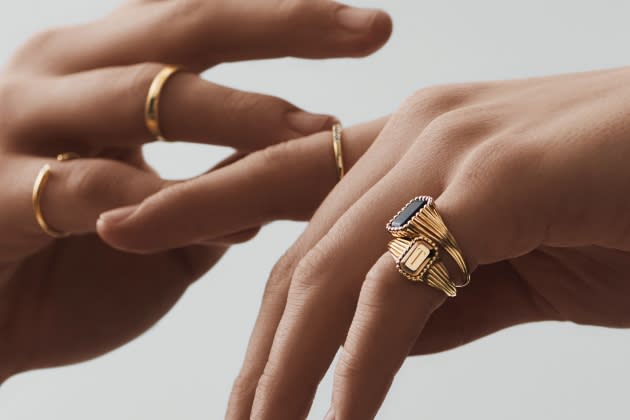Mejuri Releases Sustainability Report, Invests in ‘Regenerative Mining’

Millennial-favorite jewelry brand Mejuri has released its very first sustainability report, as well as news of an investment.
In the report, the brand details its emissions impact, sourcing strategies, partnerships and more throughout its near-decade in business. As part of its new partnership with ecological restoration-focused B Corp Regeneration, the jewelry brand will invest $1.5 million to support the restoration of former legacy mines. Regeneration’s projects aim to safely extract by-product minerals from leftover tailings from mines, waterways and the like. This project works similarly to Mejuri’s existing regenerative mining partnership with Salmon Gold (also owned by NGO Resolve) which the brand initiated last year.
More from WWD
“When I started Mejuri in January 2015, I wanted to do things differently. I wanted to flip the traditional industry narrative by turning fine jewelry into an everyday occasion, build a meaningful brand, and empower women to celebrate themselves,” Mejuri cofounder and chief executive officer Noura Sakkijha said in the report. “And with big intentions comes big responsibility. We hold ourselves to high standards in every way and part of that is making the right choices when it comes to decisions that impact our people and planet. As we’ve grown, we’re ready to take on even more accountability with our first sustainability report.”
In a past interview with WWD, Sakkijha shared the metrics behind this mission. She said 70 percent to 80 percent of Mejuri customers are buying their jewels for themselves, as opposed to a partner buying for them. Along with that, price is a value proposition with Mejuri, boasting products like the “Bold Huggie Hoops” priced at $178 as opposed to the market price estimated at $450 though markup calculations are not given.
Today, the female-fronted brand counts 560 employees (77 percent of whom identify as women). There are 22 stores, with expansion on the horizon.
As noted in the report, the company began tracking its greenhouse gas emissions three years ago (though it is not a signatory to the Science Based Targets Initiative). Today, the majority or — 98.5 percent of Mejuri’s emissions — comes from scope 3, or the extended supply chain, which is on par with apparel emissions. This is progress down from 99.2 percent in 2022.
The brand also touts carbon credits (purchased via carbon offset partner Native) and recycled metals (mostly recycled gold) as key to reducing impact without limiting its growth. As with others like Reformation, the brand is looking to reduce its carbon intensity, or the energy it takes to make its products. This figure dropped from 0.18 to 0.10 metric tonnes carbon dioxide equivalents per $1,000 net revenue in 2021, the brand estimated.
Under the Mejuri Empowerment Fund, the brand delivered $324,000 in scholarships with partners such the Jeanette Rankin Foundation, which empowers women aged 35 and older to complete their college degrees, and Indspire, whose scholarships go toward First Nations, Inuit and Métis students.
In 2021, Mejuri took strides in materials and circularity starting with recycled metals and minerals. Last year, 95 percent of its gold came from recycled sources. Mejuri’s money maker, 14-karat gold products, make up the majority of its revenue. When it comes to silver, 92 percent came from recycled sources in 2022.
Last year, Mejuri expanded its responsible sourcing program, requiring sourcing partners to abide by the Responsible Mining Assurance (a third-party ESG audit) and the Responsible Jewellery Council (which focuses on building a conflict-free diamond supply chain). Mejuri said jewelry partners source their materials from refiners who have participated in audits done by the RJC, Independent Precious Metals Authority and Responsible Minerals Initiative. Returned or defective products that can’t be repaired are sent to Mejuri’s recycler to be melted down for new products. Mejuri did not detail the extent of its repair program.
As highlighted in the report, the brand also launched Mejuri ID, which maps the jewelry’s components, as well as a life cycle assessment, to showcase continued traceability ambitions.
As for what’s next, Mejuri is a Butterfly Mark hopeful, per its report, though the brand did not specify when it hopes to achieve the luxury certification. Other goals span helping more of its suppliers convert to solar technology (only two were noted in the report) and the rollout of polybag recycling, though no details were outlined.
Sakkijha said that the report is a work in progress. “As we continue to grow, we are committed to showing up every day to do the work.”
Best of WWD
